
Understanding Emissions
Scope 1, scope 2 and scope 3 emissions are distinct categories of greenhouse gas reporting. Scope 4 however, adds a slightly different dimension. Read on to find out more..
Definitions of scope 1, 2 and 3 emissions
Essentially, scope 1 are those direct emissions that are owned or controlled by a company, whereas scope 2 and 3 indirect emissions are a consequence of the activities of the company but occur from sources not owned or controlled by it.
Scope 1 emissions
Scope 1 covers emissions from sources that an organisation owns or controls directly – for example from burning fuel in our fleet of vehicles (if they’re not electrically-powered).
Scope 2 emissions
Scope 2 are emissions that a company causes indirectly and come from where the energy it purchases and uses is produced. For example, the emissions caused when generating the electricity that we use in our buildings would fall into this category.
Scope 3 emissions
Scope 3 encompasses emissions that are not produced by the company itself and are not the result of activities from assets owned or controlled by them, but by those that it’s indirectly responsible for up and down its value chain. An example of this is when we buy, use and dispose of products from suppliers. Scope 3 emissions include all sources not within the scope 1 and 2 boundaries.
Scope 4 emissions
In contrast to the above, scope 4 emissions focus on the reduction of emissions achieved by the use of a company's products or services. Scope 4 is a relatively new concept that focuses on the positive side of the equation - emissions that are avoided through a company's products or services. For example, a company that manufactures energy-efficient appliances can claim the avoided emissions from those appliances replacing less efficient models.
What do all these mean for the cleaning industry?
Scope 1?
1. The use of fuel in company vehicles for transportation to cleaning sites.
2. On-site generators used for power during cleaning (especially relevant for industrial cleaning).
3. Fugitive emissions from cleaning chemicals, like aerosols.
These emissions directly contribute to the industry's carbon footprint and air pollution. Think of it as the emissions that happen right on your company's doorstep.
Scope 2?
1. Electricity used in cleaning facilities for equipment and lighting.
2. Heating usage. For example, any hot water and heating used during cleaning hours.
3. Head office emissions attributable to site (allocated proportionate to revenue or hours).
The cleaning industry relies on a variety of equipment and chemicals, and the environmental impact of their production contributes to the industry's footprint. While you don't directly control how this energy is produced, you are responsible for the emissions associated with its generation.
Scope 3?
1. Emissions associated with the production, transportation, and disposal of cleaning chemicals and equipment.
2. Emissions from the lifecycle of cleaning materials like paper towels and microfibre cloths.
3. Raw material extraction (as thoroughly as data is available; gaps filled with best estimate data).
4. Manufacturing (as thoroughly as data is available; gaps filled with best estimate data).
5. Transport to Warehouse - import and UK transport.
6. Transport to site - own vehicle and 3rd party.
7. Collection for re-use.
These emissions highlight the broader environmental impact of the cleaning industry beyond just the activities at the cleaning site itself. Tracking Scope 3 emissions can be a challenge due to the complex nature of supply chains, but it's also where significant emission reduction opportunities often lie.
Scope 4?
Scope 4 emissions or 'avoided emissions' are defined as the reductions in greenhouse gas emissions that occur outside of a product's or service's life cycle or value chain, but as a direct result of using that product or service. In other words, any emission reductions gained by using a particular product or service can be reported as part of the company's contribution to carbon reduction.
Companies now are being encouraged to proactively look into adopting this method of reporting, as it has two-fold benefits - both for the business and the environment.
Although Scope 1, 2 and 3 measure the greenhouse gas emissions from the business, Scope 4 is quickly becoming the new evolution of CO2e management.
Get in touch with the Foremost team today!
Fill in the form below:




